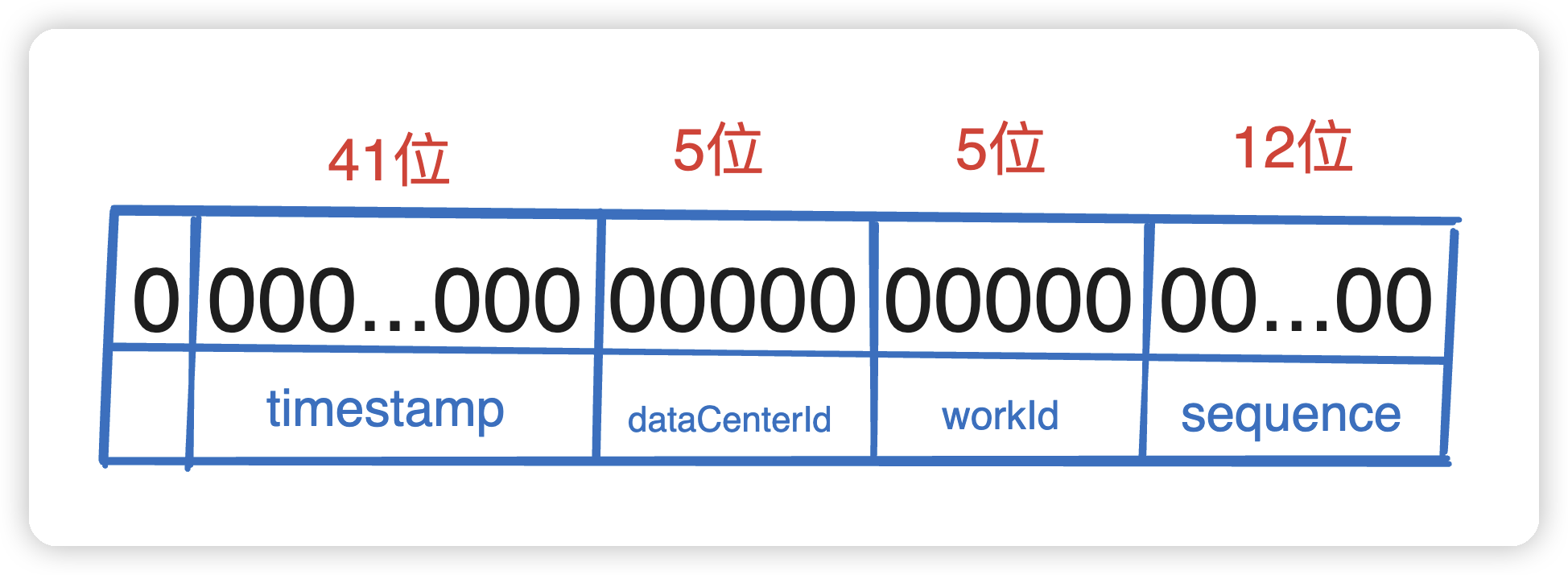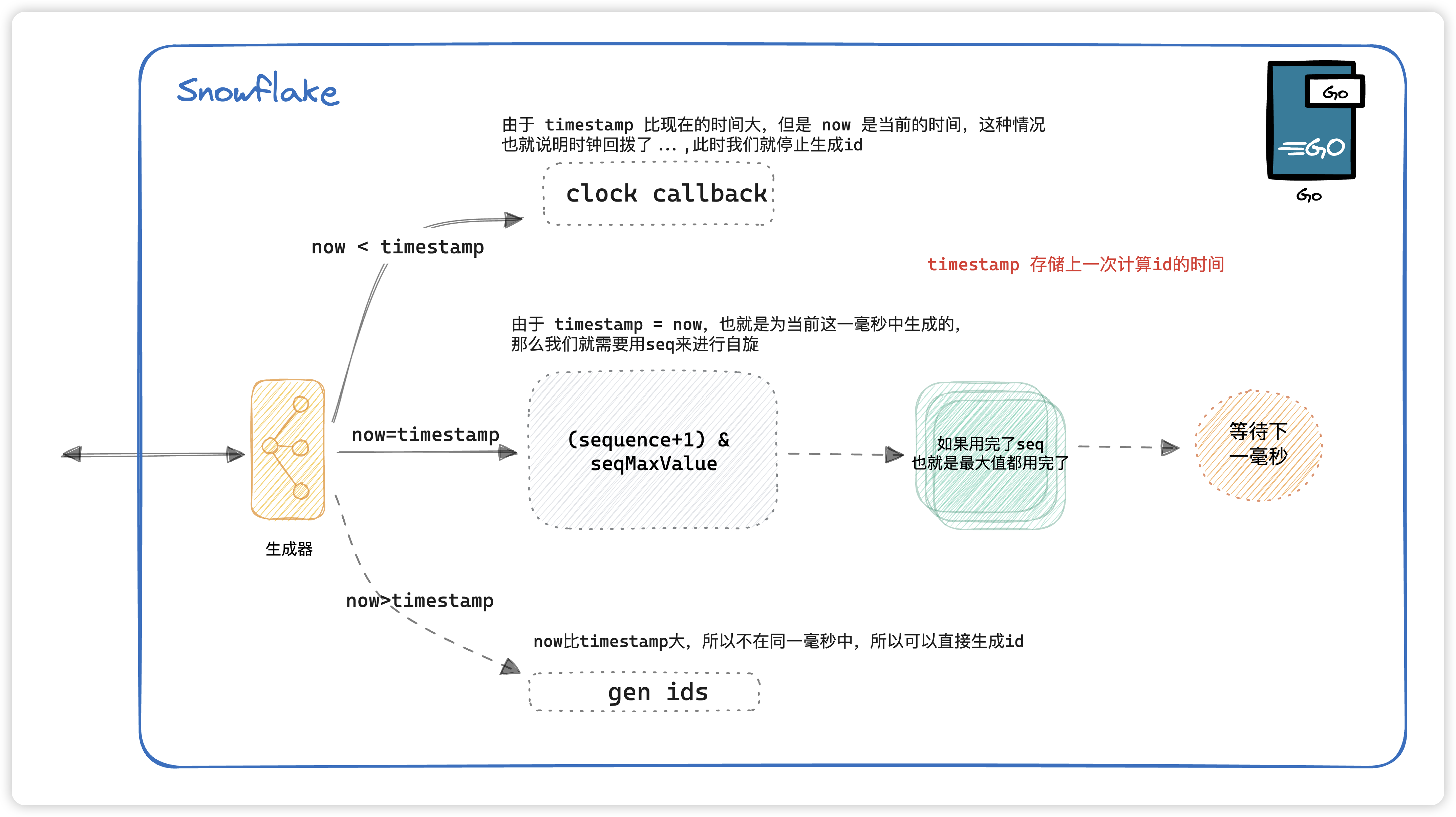寫在前面
在分布式領域中,不可避免的需要生成一個全局唯一ID。而在近幾年的發展中有許多分布式ID生成算法,比較經典的就是 Twitter 的雪花算法(Snowflake Algorithm)。當然國內也有美團的基于snowflake改進的Leaf算法。那么今天我們就來介紹一下雪花算法。
雪花算法
算法來源: 世界上沒有完全相同的兩片雪花 。所以!雪崩的時候,沒有任何一片雪花是相同的!
雪花算法的本質是生成一個64位的 long int 類型的id,可以拆分成一下幾個部分:
- 最高位固定位0。因為第一位為
符號位,如果是1那么就是負數了。 - 接下來的
41 位存儲毫秒級時間戳,2^41 大概可以使用69年。 - 再接來就是10位存儲機器碼,包括
5 位dataCenterId 和 5 位 workerId。最多可以部署2^10=1024臺機器。 - 最后12位存儲序列號。統一毫秒時間戳時,通過這個遞增的序列號來區分。
即對于同一臺機器而言,同一毫秒時間戳下可以生成 2^12=4096 個不重復id。

雪花算法其實是強依賴于時間戳的,因為我們看上面生成的幾個數字,我們唯一不可控的就是時間,如果發生了時鐘回撥有可能會發生id生成一樣了。
所以雪花算法適合那些與時間有強關聯的業務 ,比如訂單,交易之類的,需要有時間強相關的業務。
生成 ID 流程圖

下面會結合代碼講述詳細講述這張圖
代碼實現
前置工作
既然是由上述的幾個部分組成,那么我們可以先定義幾個常量
// 時間戳的 占用位數
timestampBits = 41
// dataCenterId 的占用位數
dataCenterIdBits = 5
// workerId 的占用位數
workerIdBits = 5
// sequence 的占用位數
seqBits = 12
并且定義各個字段的最大值,防止越界
// timestamp 最大值, 相當于 2^41-1 = 2199023255551
timestampMaxValue = -1 ^ (-1 << timestampBits)
// dataCenterId 最大值, 相當于 2^5-1 = 31
dataCenterIdMaxValue = -1 ^ (-1 << dataCenterIdBits)
// workId 最大值, 相當于 2^5-1 = 31
workerIdMaxValue = -1 ^ (-1 << workerIdBits)
// sequence 最大值, 相當于 2^12-1 = 4095
seqMaxValue = -1 ^ (-1 << seqBits)
移動位數
// workId 向左移動12位(seqBits占用位數)因為這12位是sequence占的
workIdShift = 12
// dataCenterId 向左移動17位 (seqBits占用位數 + workId占用位數)
dataCenterIdShift = 17
// timestamp 向左移動22位 (seqBits占用位數 + workId占用位數 + dataCenterId占用位數)
timestampShift = 22
定義雪花生成器的對象,定義上面我們介紹的幾個字段即可
type SnowflakeSeqGenerator struct {mu *sync.Mutextimestamp int64dataCenterId int64workerId int64sequence int64
}
func NewSnowflakeSeqGenerator(dataCenterId, workId int64) (r *SnowflakeSeqGenerator, err error) {if dataCenterId < 0 || dataCenterId > dataCenterIdMaxValue {err = fmt.Errorf("dataCenterId should between 0 and %d", dataCenterIdMaxValue-1)return}if workId < 0 || workId > workerIdMaxValue {err = fmt.Errorf("workId should between 0 and %d", dataCenterIdMaxValue-1)return}return &SnowflakeSeqGenerator{mu: new(sync.Mutex),timestamp: defaultInitValue - 1,dataCenterId: dataCenterId,workerId: workId,sequence: defaultInitValue,}, nil
}
具體算法
timestamp存儲的是上一次的計算時間,如果當前的時間比上一次的時間還要小,那么說明發生了時鐘回撥,那么此時我們不進行生產id,并且記錄錯誤日志。
now := time.Now().UnixMilli()
if S.timestamp > now { // Clock callbacklog.Errorf("Clock moved backwards. Refusing to generate ID, last timestamp is %d, now is %d", S.timestamp, now)return ""
}
如果時間相等的話,那就說明這是在 同一毫秒時間戳內生成的 ,那么就進行seq的自旋,在這同一毫秒內最多生成 4095 個。如果超過4095的話,就等下一毫秒。
if S.timestamp == now {
// generate multiple IDs in the same millisecond, incrementing the sequence number to prevent conflictsS.sequence = (S.sequence + 1) & seqMaxValueif S.sequence == 0 {// sequence overflow, waiting for next millisecondfor now <= S.timestamp {now = time.Now().UnixMilli()}}
}
那么如果是不在同一毫秒內的話,seq直接用初始值就好了
else {// initialized sequences are used directly at different millisecond timestampsS.sequence = defaultInitValue
}
如果超過了69年,也就是時間戳超過了69年,也不能再繼續生成了
tmp := now - epoch
if tmp > timestampMaxValue {log.Errorf("epoch should between 0 and %d", timestampMaxValue-1)return ""
}
記錄這一次的計算時間,這樣就可以和下一次的生成的時間做對比了。
S.timestamp = now
將 timestamp + dataCenterId + workId + sequence 拼湊一起,注意一點是我們最好用字符串輸出,因為前端js中的number類型超過53位會溢出的。
// combine the parts to generate the final ID and convert the 64-bit binary to decimal digits.
r := (tmp)<<timestampShift |(S.dataCenterId << dataCenterIdShift) |(S.workerId << workIdShift) |(S.sequence)return fmt.Sprintf("%d", r)
完整代碼 & 測試文件
package sequenceimport ("fmt""sync""time""github.com/seata/seata-go/pkg/util/log"
)// SnowflakeSeqGenerator snowflake gen ids
// ref: https://en.wikipedia.org/wiki/Snowflake_IDvar (// set the beginning timeepoch = time.Date(2024, time.January, 01, 00, 00, 00, 00, time.UTC).UnixMilli()
)const (// timestamp occupancy bitstimestampBits = 41// dataCenterId occupancy bitsdataCenterIdBits = 5// workerId occupancy bitsworkerIdBits = 5// sequence occupancy bitsseqBits = 12// timestamp max value, just like 2^41-1 = 2199023255551timestampMaxValue = -1 ^ (-1 << timestampBits)// dataCenterId max value, just like 2^5-1 = 31dataCenterIdMaxValue = -1 ^ (-1 << dataCenterIdBits)// workId max value, just like 2^5-1 = 31workerIdMaxValue = -1 ^ (-1 << workerIdBits)// sequence max value, just like 2^12-1 = 4095seqMaxValue = -1 ^ (-1 << seqBits)// number of workId offsets (seqBits)workIdShift = 12// number of dataCenterId offsets (seqBits + workerIdBits)dataCenterIdShift = 17// number of timestamp offsets (seqBits + workerIdBits + dataCenterIdBits)timestampShift = 22defaultInitValue = 0
)type SnowflakeSeqGenerator struct {mu *sync.Mutextimestamp int64dataCenterId int64workerId int64sequence int64
}// NewSnowflakeSeqGenerator initiates the snowflake generator
func NewSnowflakeSeqGenerator(dataCenterId, workId int64) (r *SnowflakeSeqGenerator, err error) {if dataCenterId < 0 || dataCenterId > dataCenterIdMaxValue {err = fmt.Errorf("dataCenterId should between 0 and %d", dataCenterIdMaxValue-1)return}if workId < 0 || workId > workerIdMaxValue {err = fmt.Errorf("workId should between 0 and %d", dataCenterIdMaxValue-1)return}return &SnowflakeSeqGenerator{mu: new(sync.Mutex),timestamp: defaultInitValue - 1,dataCenterId: dataCenterId,workerId: workId,sequence: defaultInitValue,}, nil
}// GenerateId timestamp + dataCenterId + workId + sequence
func (S *SnowflakeSeqGenerator) GenerateId(entity string, ruleName string) string {S.mu.Lock()defer S.mu.Unlock()now := time.Now().UnixMilli()if S.timestamp > now { // Clock callbacklog.Errorf("Clock moved backwards. Refusing to generate ID, last timestamp is %d, now is %d", S.timestamp, now)return ""}if S.timestamp == now {// generate multiple IDs in the same millisecond, incrementing the sequence number to prevent conflictsS.sequence = (S.sequence + 1) & seqMaxValueif S.sequence == 0 {// sequence overflow, waiting for next millisecondfor now <= S.timestamp {now = time.Now().UnixMilli()}}} else {// initialized sequences are used directly at different millisecond timestampsS.sequence = defaultInitValue}tmp := now - epochif tmp > timestampMaxValue {log.Errorf("epoch should between 0 and %d", timestampMaxValue-1)return ""}S.timestamp = now// combine the parts to generate the final ID and convert the 64-bit binary to decimal digits.r := (tmp)<<timestampShift |(S.dataCenterId << dataCenterIdShift) |(S.workerId << workIdShift) |(S.sequence)return fmt.Sprintf("%d", r)
}
測試文件
func TestSnowflakeSeqGenerator_GenerateId(t *testing.T) {var dataCenterId, workId int64 = 1, 1generator, err := NewSnowflakeSeqGenerator(dataCenterId, workId)if err != nil {t.Error(err)return}var x, y stringfor i := 0; i < 100; i++ {y = generator.GenerateId("", "")if x == y {t.Errorf("x(%s) & y(%s) are the same", x, y)}x = y}
}---數字圖像)
(八))

——排序算法)



按鍵產生中斷)


、查看equals底層、final--學習JavaEE的day15)
)

部署CNI網絡插件(4))



算法)
)
